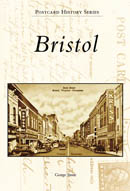

George Stone compiled a book of post cards refecting Bristol's history.
*** This story appeared in the Bristol Herald Courier on May 8, 2008.***
For George Stone, compiling a history of Bristol using old postcards meant largely paying tribute to his father.
The late Paul Stone owned nearly 400 postcards ? including dozens of shots of State Street in Bristol.
That collection inspired the younger Stone to issue a sequel to a previous local history book, Bristol: Images of America (Arcadia Publishing, $19.99), that he co-authored with Sonya A. Haskins in 2005.
"I knew that Arcadia Publishing also did a postcard history series," Stone said. "So, it only seemed natural to do a postcard history of Bristol. I really wanted to do this book to honor [my father] and his passion for postcards."
Passion? Indeed. Stone remembered his father "meticulously sorting through his cards, going to antique shops and flea markets, searching for that special postcard of his hometown."
'PRE-1950'
Collectors contributing other images included Tim Buchanan, Blaine Wade, Larry Greer, Dan and Robin Pless, Steve Dixon and Shelby Edwards.
Many of the postcards in "Bristol: Postcard History Series" (Arcadia Publishing, $19.99) are about a century old.
"Close to 75 percent of the postcards in the book date pre-1950," Stone said. "But the most recent is from 1994 showing Bristol Regional Medical Center as the third of three hospital postcards, including King's Mountain and Bristol Memorial."
An avid baseball fan, Stone figured the book's rarest image is a 1911 postcard of Bristol's Appalachian League baseball team. "I have never seen another one of these cards," Stone said, "nor have I even seen a photograph of that team."
'DIFFERENT FEEL'
Born at Bristol in 1952, Stone began a career in journalism in 1976 and ultimately became the sports editor of the Bristol Herald Courier.
"As a native of Bristol, the postcards are interesting as they show how the city has changed over the past 100 years," Stone said. "But I feel the book will appeal even to non-Bristolians simply because of the architecture of some of the buildings which no longer stand."
While working on the project, Stone got an idea to write essays to begin each of his chapters, focused on subjects like King College, Virginia Intermont College, Sullins College and Bristol's Train Station.
Those essays, he said, set this book apart from his previous Arcadia release.
"At the same time," he added, "the two books have a different feel simply because postcards give a personal touch. Postcards were a way of communicating in the early 1900s, and several of these postcards are from girlfriend to boyfriend, husband to wife and parents to children."
'SOMETHING NEW'
Besides collecting images, Stone also researched each image to give the postcards a historical perspective.
"The best source I had was Bud Phillips, Bristol's resident historian," Stone said.
Now, Stone hopes his 128-page book will "take its place on the bookshelves of Bristol alongside other works which tell the history of the city, and that it can be used as a resource for the next aspiring author who wants to delve into the city's history."
Stone laughed. "I am hoping that readers will discover something new about Bristol that perhaps they did not know before, just as I did while researching for the book," he said.
YOU SHOULD KNOW
Title: "Bristol: Postcard History Series"
Author: George Stone
Orders: (888)-313-2665
Web: www.arcadiapublishing.com